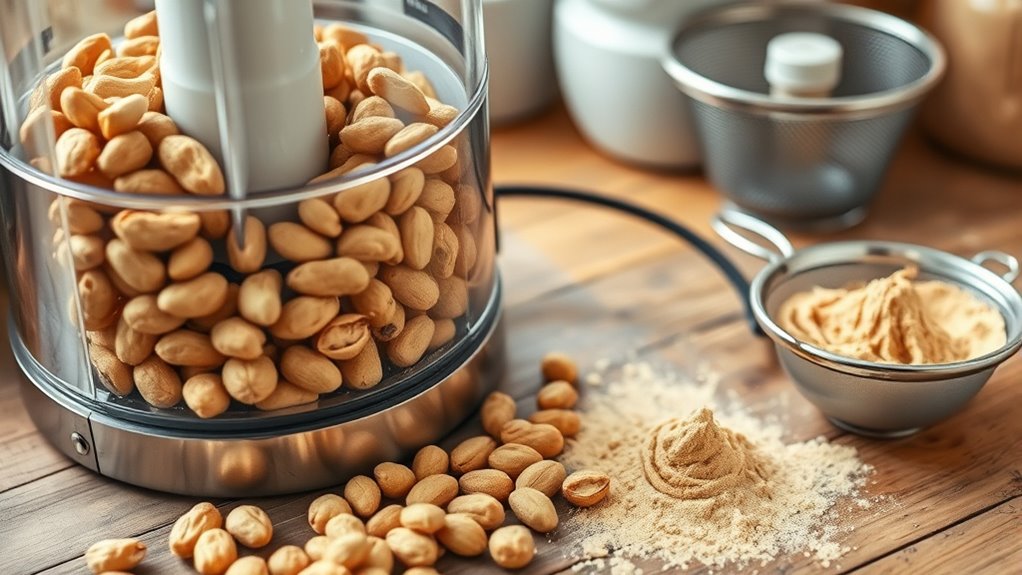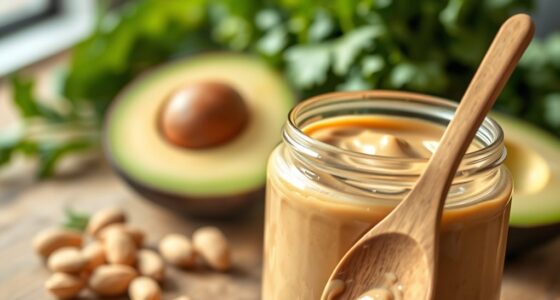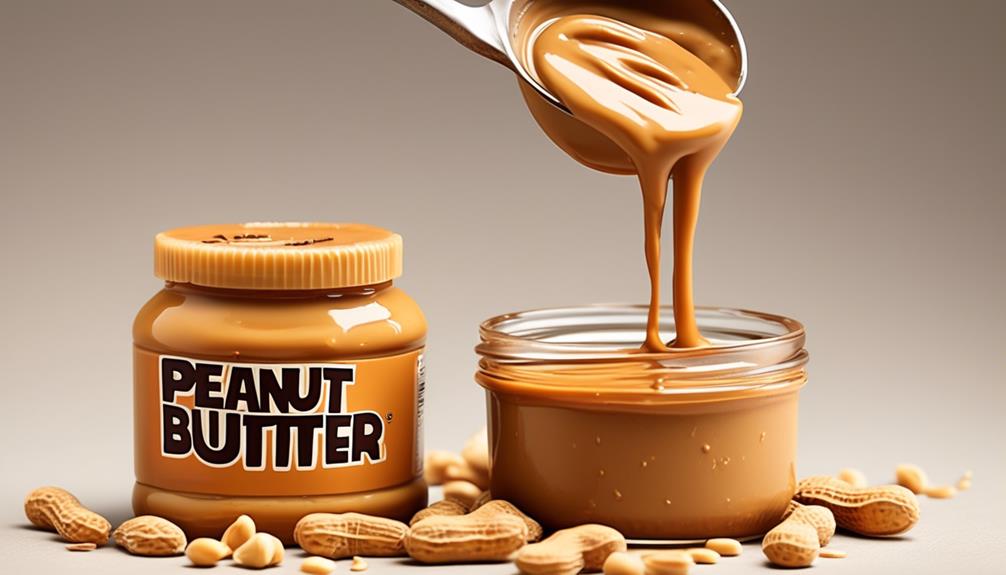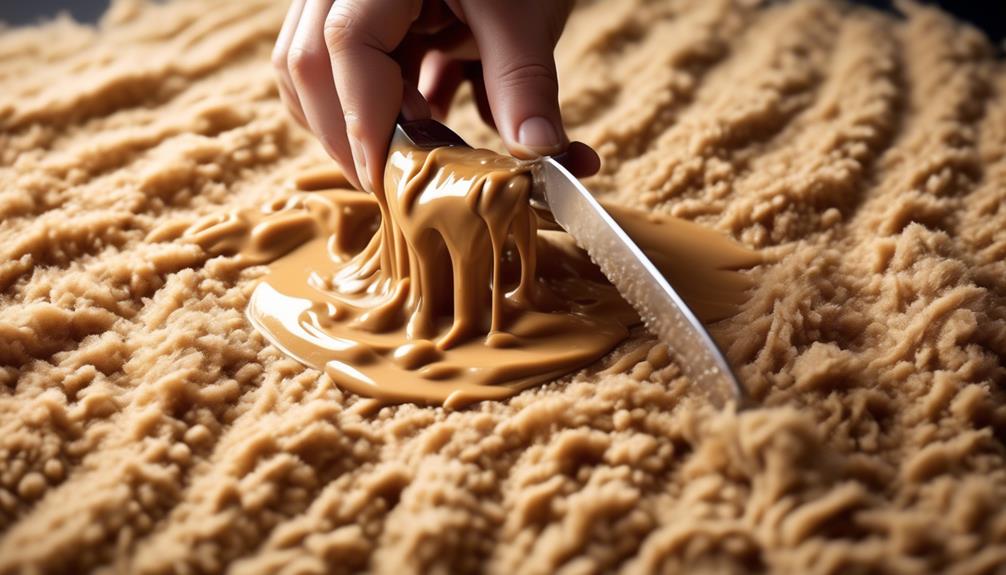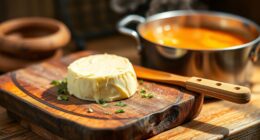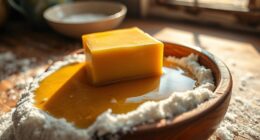To make peanut butter powder at home, start by selecting high-quality, organic peanuts and roasting them at 350°F–375°F to boost flavor and loosen fat. Then, blanch the roasted nuts in hot water to remove surface oil, drain, and dry thoroughly using an oven or dehydrator. Once dry, grind the peanuts into a fine powder with a high-powered blender. Adding flavors or storing properly helps maintain freshness. Keep following these steps to master the de-fatting process seamlessly.
Key Takeaways
- Select high-quality, organic peanuts free from mold and damage for optimal flavor and fat content.
- Roast peanuts at 350°F–375°F for 10–15 minutes to enhance flavor and loosen surface oils.
- Blanch roasted peanuts in hot water, then thoroughly dry to reduce moisture and facilitate fat removal.
- Grind dried peanuts until fine using a high-powered blender, avoiding over-processing to prevent pasty texture.
- Store the peanut powder in airtight containers in a cool, dry place to maintain freshness and prevent moisture absorption.
Selecting the Right Peanuts for De‑Fatting
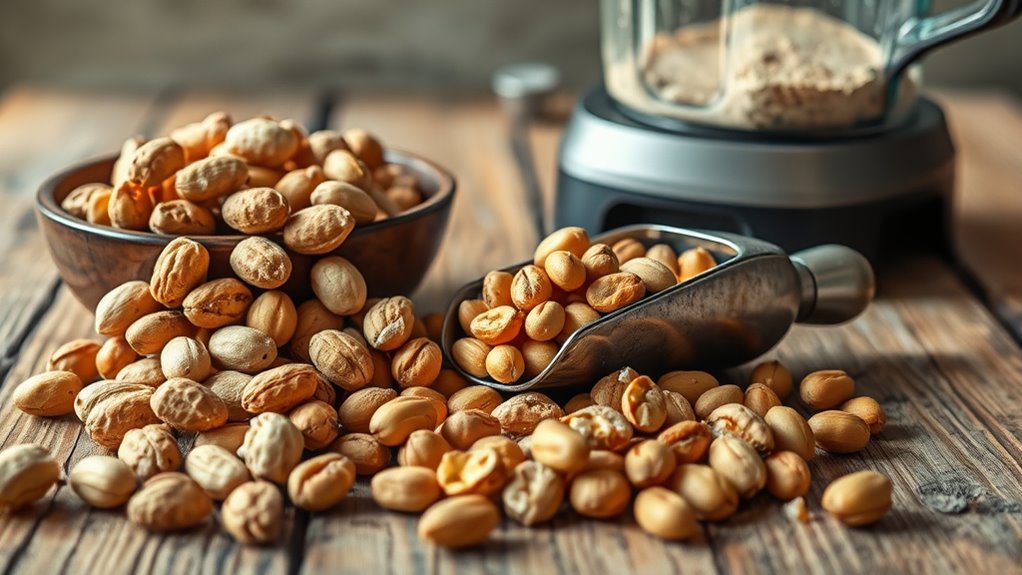
Choosing the right peanuts is essential for making high-quality peanut butter powder. Start by selecting organic peanuts to guarantee purity and better flavor. Organic peanuts are free from pesticides and additives, giving you a cleaner, healthier end product. Before processing, remove the peanut shells carefully; shell removal helps prevent any bitter tastes or unwanted textures in your powder. Handpicking or using a shelling machine makes this step easier. Opt for peanuts that are uniformly sized and free from mold or damage, as these qualities influence flavor and processing efficiency. Proper soil health and cultivation practices can also impact the quality and flavor of your peanuts. By choosing high-quality, organic peanuts and thoroughly removing shells, you set a strong foundation for a smooth, flavorful peanut butter powder with optimal fat content.
Roasting Peanuts to Enhance Flavor and Ease Fat Removal
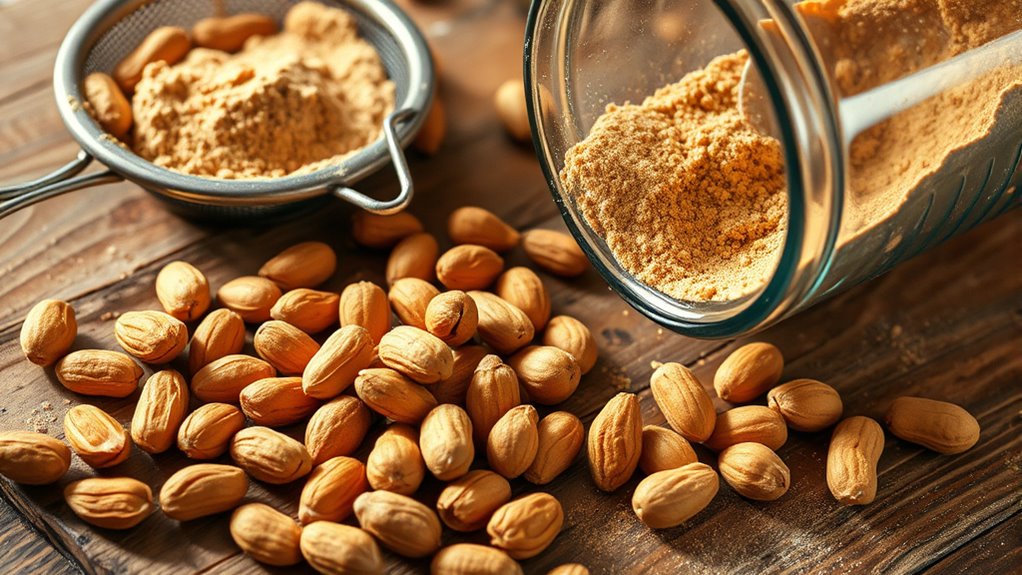
Roasting peanuts is a crucial step that considerably boosts their flavor and makes fat removal easier. Before roasting, remove the peanut shells to guarantee even heat distribution and better flavor. Set your oven to a roasting temperature between 350°F and 375°F, which is ideal for bringing out rich taste without burning the nuts. Spread the peanuts in a single layer on a baking sheet, allowing heat to circulate evenly. Roast for about 10–15 minutes, stirring occasionally to prevent uneven cooking. The roasting process not only enhances the peanuts’ nutty aroma but also loosens fat, simplifying subsequent de-fatting steps. Proper roasting sets the foundation for making smooth, flavorful peanut butter powder at home. Roasting techniques can significantly influence the final flavor and texture of your homemade peanut products.
Removing Oil Through Blanching and Drying Techniques
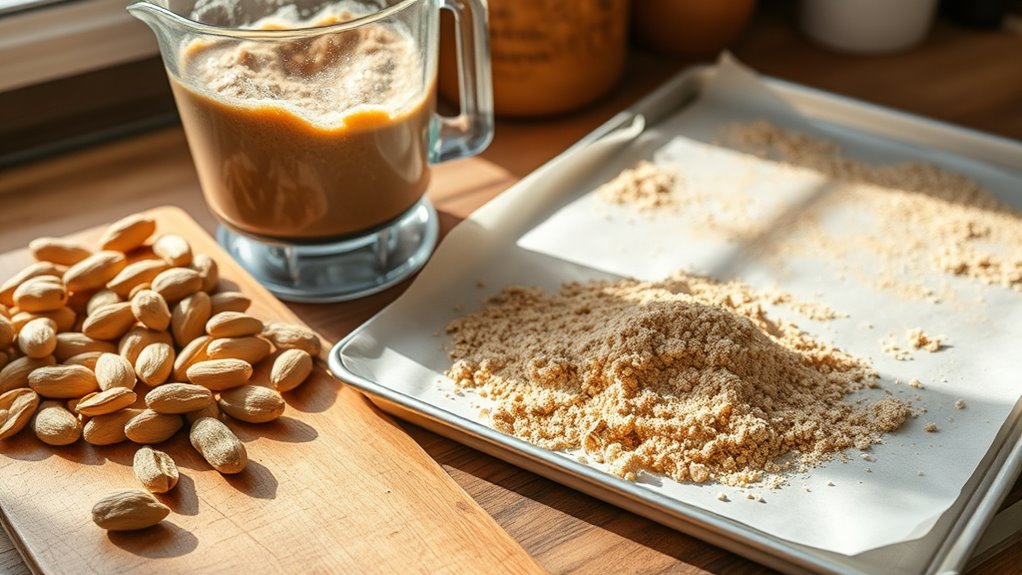
After roasting the peanuts, the next step is to remove excess oil to achieve a smoother, less greasy powder. Blanching helps loosen the oil and makes extraction easier. Submerge the roasted peanuts in hot water briefly, then drain and pat them dry. Next, spread the peanuts on a baking sheet and dry them thoroughly using an oven or dehydrator. This drying process reduces surface moisture, facilitating oil extraction during grinding. As you dry, the heat also minimizes moisture that can interfere with flavor infusion later. The combination of blanching and drying effectively removes much of the oil, resulting in a lighter powder. This method enhances the peanut flavor and ensures your homemade peanut powder isn’t overly greasy, making it ideal for baking, smoothies, or flavoring other recipes. Incorporating proper drying techniques can further improve oil removal and powder quality.
Achieving the Perfect Texture for Your Peanut Powder
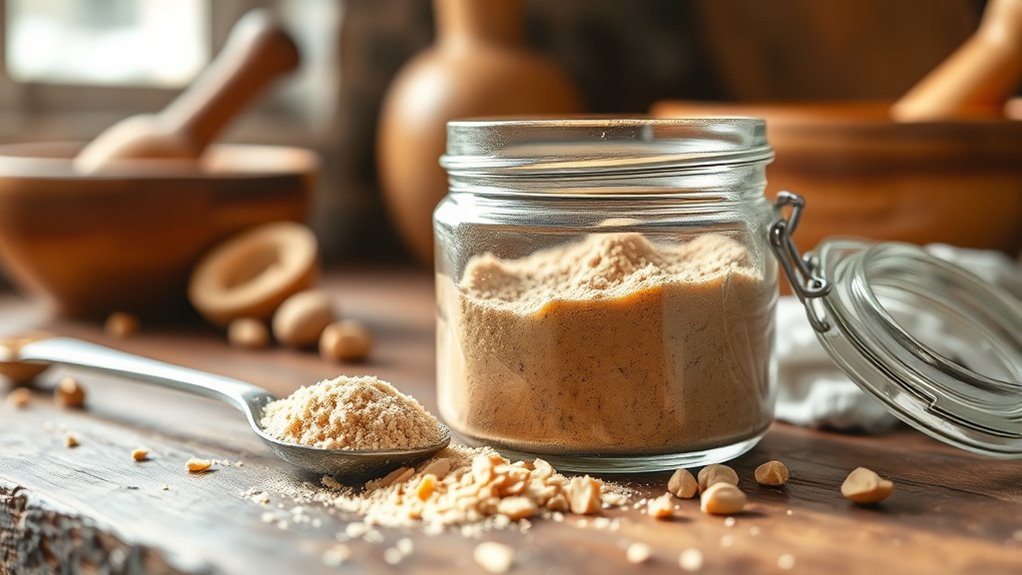
To achieve the perfect texture for your peanut powder, it’s vital to grind the peanuts just until they reach a fine, uniform consistency. Over-grinding can lead to a pasty or sticky texture, while under-grinding results in coarse particles. Pay attention to texture consistency by stopping when the powder is smooth and evenly ground. Moisture control is essential—excess moisture can cause clumping and hinder proper drying, so make sure the peanuts are thoroughly dried beforehand. Use a high-powered blender or food processor, pulsing gradually to avoid overheating and uneven texture. Keep the mixture dry throughout the process, and periodically check the consistency. Achieving the right texture makes your peanut powder easier to incorporate into recipes and ensures it stores well without clumping. Additionally, understanding cookie categories can help you select the best tools and techniques for processing your peanut powder efficiently.
Incorporating Additional Flavors and Enhancements
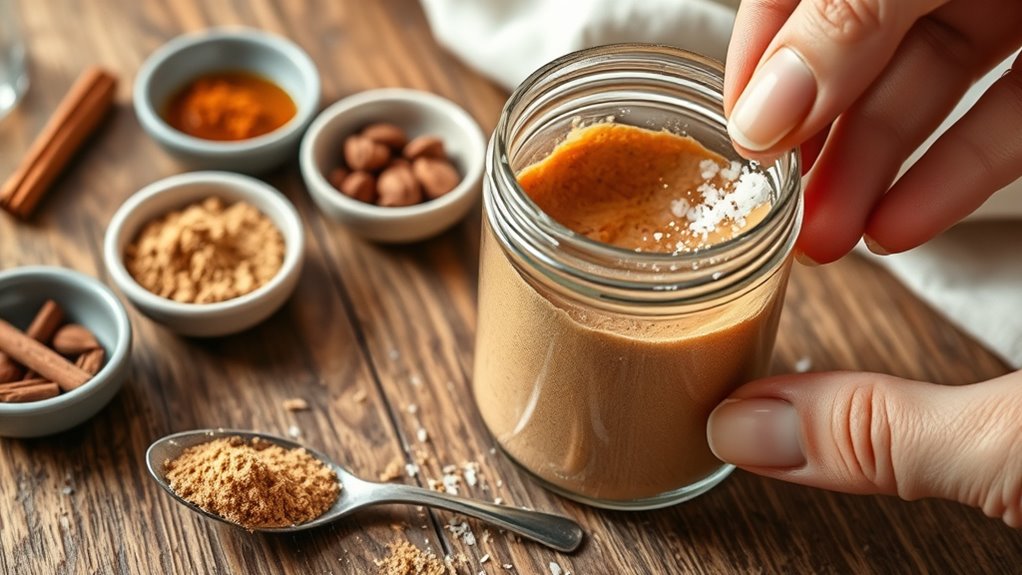
Adding flavors and enhancements to your peanut powder can elevate its versatility and taste. You can experiment with adding spices like cinnamon, cocoa powder, or chili for unique twists. Sweetening options such as honey, stevia, or powdered sugar can also improve flavor without adding liquid. Mix these in thoroughly to ensure even distribution. To inspire your creativity, here’s a quick guide:
| Flavor Type | Examples | Usage Ideas |
|---|---|---|
| Spices | Cinnamon, nutmeg, cayenne | Add to smoothies, baked goods |
| Sweeteners | Honey, stevia, powdered sugar | Top on oatmeal, yogurt |
| Enhancements | Cocoa powder, vanilla extract | Make chocolate peanut powder |
Feel free to combine flavors for even more delicious results! Understanding flavor pairing can help you create harmonious combinations for your homemade peanut powder.
Storing and Using Your Homemade Peanut Butter Powder
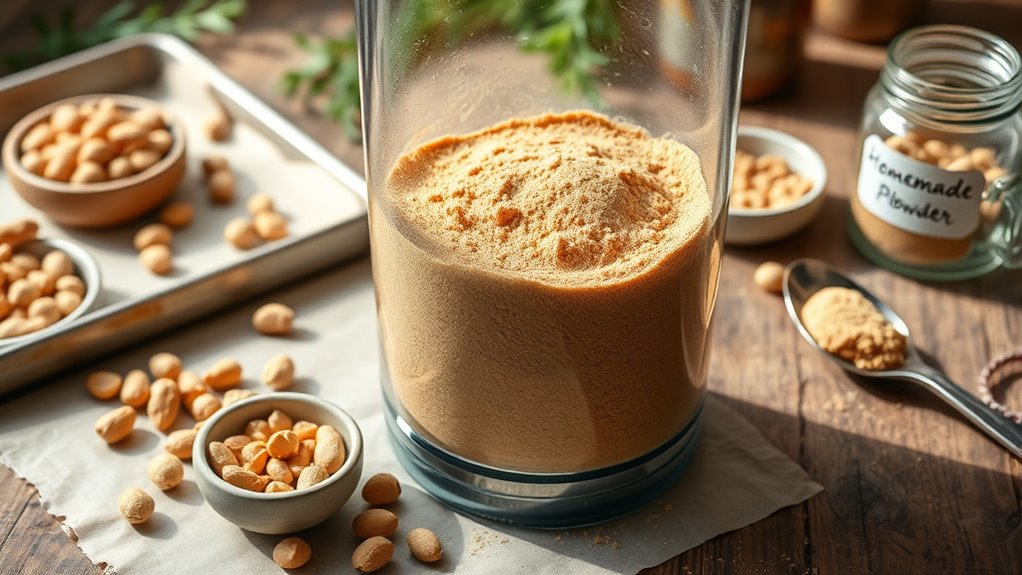
Once you’ve prepared your homemade peanut butter powder, proper storage is essential to maintain its freshness and flavor. Use an airtight container to protect it from moisture and air, which can cause spoilage and reduce shelf life. Store the container in a cool, dry place away from direct sunlight. Good nut storage practices help prevent the powder from becoming rancid or clumping. To extend its shelf life, consider refrigeration, especially if you live in a humid climate. Properly stored, your peanut butter powder can last several months. Before using, give it a quick sniff and visual check to ensure freshness. Keep the container sealed tightly after each use to preserve flavor and prevent contamination. Maintaining color accuracy in your storage environment can also help preserve the powder’s appearance and quality. With these tips, your homemade peanut butter powder stays fresh and ready whenever you need it.
Frequently Asked Questions
Can I Make Peanut Butter Powder From Flavored or Salted Peanuts?
You can make peanut butter powder from flavored or salted peanuts, but keep in mind that the added flavors and salt will carry over to the powder. If you want a more neutral taste, it’s better to use plain, unsalted peanuts. With flavored or salted peanuts, you might need to rinse or process them carefully to reduce salt and flavor intensity before de-fatting and grinding into powder.
How Do I Adjust Recipes for Different Peanut Varieties?
Did you know there are over 30 varieties of peanuts? When adjusting recipes for different peanut varieties, you’ll notice flavor and oil content vary. To account for peanut variety differences, you might need to tweak the amount of liquid or sweeteners, since some peanuts are oilier or more flavorful. Experimenting helps you perfect your recipe, ensuring consistent texture and taste regardless of the peanut type you choose.
Is Homemade Peanut Powder Suitable for Baking or Cooking?
Homemade peanut powder works well for baking and cooking because it offers good shelf stability and blends easily into recipes. You might notice slight flavor differences compared to store-bought versions, but it generally remains compatible with most flavors. Use it as a protein boost in smoothies, batters, or sauces, knowing that it keeps well and enhances your dishes without adding excess oil or fat.
Can I Add Sweeteners or Preservatives to Homemade Peanut Powder?
You can add natural preservatives or alternative sweeteners to your homemade peanut powder to enhance flavor and shelf life. Natural preservatives like honey or vitamin E help prevent spoilage, while alternative sweeteners like stevia or erythritol add sweetness without extra sugar. Just be sure to mix thoroughly and store in an airtight container, keeping your peanut powder fresh longer and tailored to your taste preferences.
What Are the Nutritional Benefits of Homemade Peanut Butter Powder?
Did you know homemade peanut butter powder retains about 50% of the protein found in regular peanut butter? You gain significant nutritional enhancement and dietary benefits by making it yourself, as it’s lower in fat and free from added preservatives. This allows you to control ingredients, boost your protein intake, and enjoy a versatile, healthy addition to smoothies, baking, or snacks, all while maintaining essential nutrients naturally.
Conclusion
Now that you’ve mastered making peanut butter powder at home, you hold the key to a healthier, customizable treat. With these simple techniques, you can turn ordinary peanuts into a versatile, flavorful ingredient—like turning a plain canvas into a masterpiece. So, why settle for store-bought when you can craft your own? Embrace the process, experiment with flavors, and enjoy the satisfaction of creating something uniquely yours—your taste buds will thank you!
